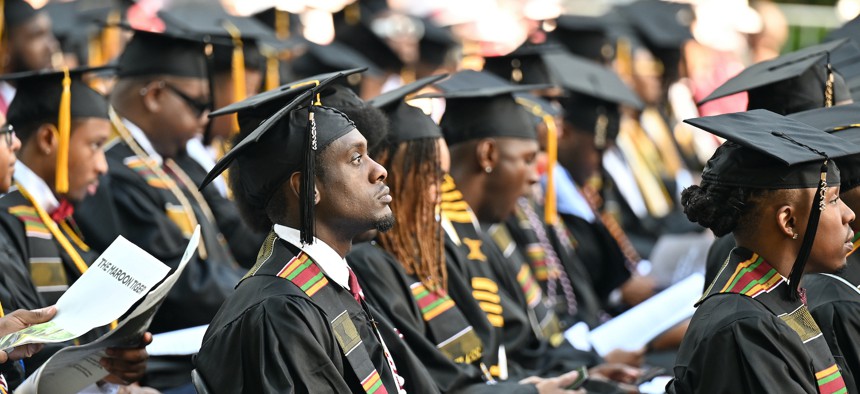
The 2023 Morehouse College commencement ceremony in Atlanta, Georgia. Paras Griffin / Getty Images
To compete with China in STEM, Pentagon should invest in HBCUs
The DOD can't leave the potential of historically Black colleges and universities untapped.
As a part of the great-power race for technological superiority, the Pentagon should use existing law and new metrics for defense-research capacity to advance eligible historically Black colleges and universities (HBCUs) to the top tier of U.S. research universities.
HBCUs, which enroll over 200,000 Black students in the United States annually, already excel at producing STEM talent from historically underrepresented demographic groups. They represent only 3 percent of U.S. colleges and universities in the United States, but they graduate 25 percent of Black students with bachelor’s degrees in STEM fields and produce almost 30 percent of Black graduates of science and engineering PhD programs.
But they could do even more, and the Pentagon cannot leave this potential untapped. The United States is lagging behind China in STEM higher education. In 2019, China produced roughly 1.6 million STEM bachelor’s graduates, while the United States produced just under 450,000. And within two years, China could be producing more than 77,000 STEM Ph.D. graduates per year while U.S. institutions produce around 40,000, according to a 2021 assessment by Georgetown University’s Center for Security and Emerging Technology.
Congress has long sought to strengthen engagement between DOD and HBCUs, beginning in the 1987 NDAA and again in the 2010, 2016, and 2020 versions. These laws have fostered multiple efforts at the Defense Department, often in coordination with the military services, but the investment in defense-research capacity at HBCUs has been meager. In 2021, this totaled roughly $20M for all HBCUs, less than one-third of 1% of the $7.4B DOD invested in science and engineering research at U.S. colleges and universities, according to National Science Foundation data. To help tackle rapidly emerging strategic challenges from global competitors, DOD should seek data- and evidence-based solutions to maximize returns on its modest investment in HBCU research capacity.
Last year, lawmakers set a fresh goal. Section 223 of the 2023 National Defense Authorization Act empowers the Defense Secretary to carry out a ten-year program to boost the nation’s defense-research capacity by helping at least some HBCUs reach top-tier research status.
U.S. research universities are graded through the Carnegie Classification of Institutions of Higher Education (CCIHE), which takes into account research expenditures, doctoral degrees conferred in science, engineering, arts, and humanities, and number of PhD research staff. With an emphasis on faculty publishing and PhD programs, R1 universities attract the most distinguished professors and stand at the forefront of research and innovation. Many also offer outstanding opportunities for undergraduates, such as research, classes taught by distinguished experts, and better preparation for graduate-level studies.
Under the Carnegie rankings, 11 HBCUs are R2 (“high research activity”) universities, which “confer at least 20 research doctorates and report at least $5 million in total research expenditures.” But none are among the nation’s 146 R1 (“very high research activity”) universities. Section 223 seeks to change that.
Along with a new goal, Section 223 adds a new requirement—inspired, in part, by a study released last year by the National Academies of Sciences, Engineering, and Medicine. The Congressionally mandated study found that the Pentagon has not usefully measured how its past spending has improved HBCU research capacity. No one knows how well they worked.
So Section 223 urges DOD to use CCIHE data to develop “measurable milestones” that reveal how eligible HBCUs are moving toward R1 status. Such metrics can be used by DOD and HBCU leaders to develop plans to help eligible R2 HBCUs to achieve R1 status—and then to maintain this gold-standard performance even after the 10-year 223 program sunsets. DOD should do this—and also develop metrics for R2 institutions to expand their defense research capacity. How? Among the newest entrants to R1 status, there are institutions that are similarly situated to the top R2 HBCUs. Making use of CCIHE data from these similarly situated R1 institutions, DOD should build an ecosystem among partners, such as FFRDCs and non-profit organizations to develop and track data-driven metrics. Together this community of interest can help DOD to continuously validate and assess leaps in research capacity required for HBCU R2 institutions to achieve top-tier research status.
Jaret Riddick is a senior fellow at Georgetown University’s Center for Security and Emerging Technology (CSET).



